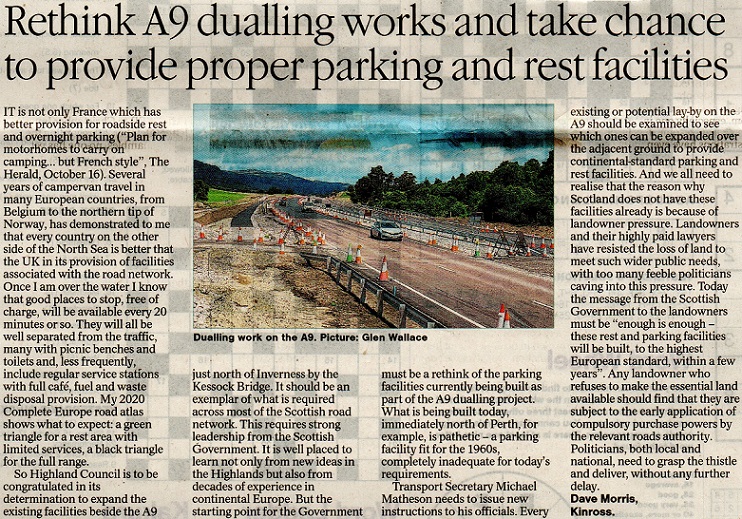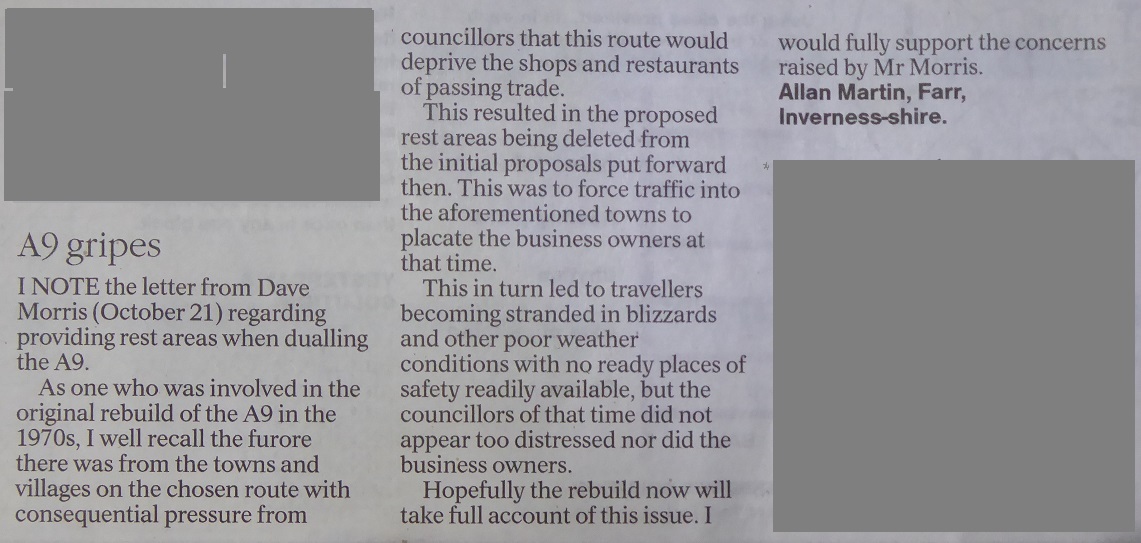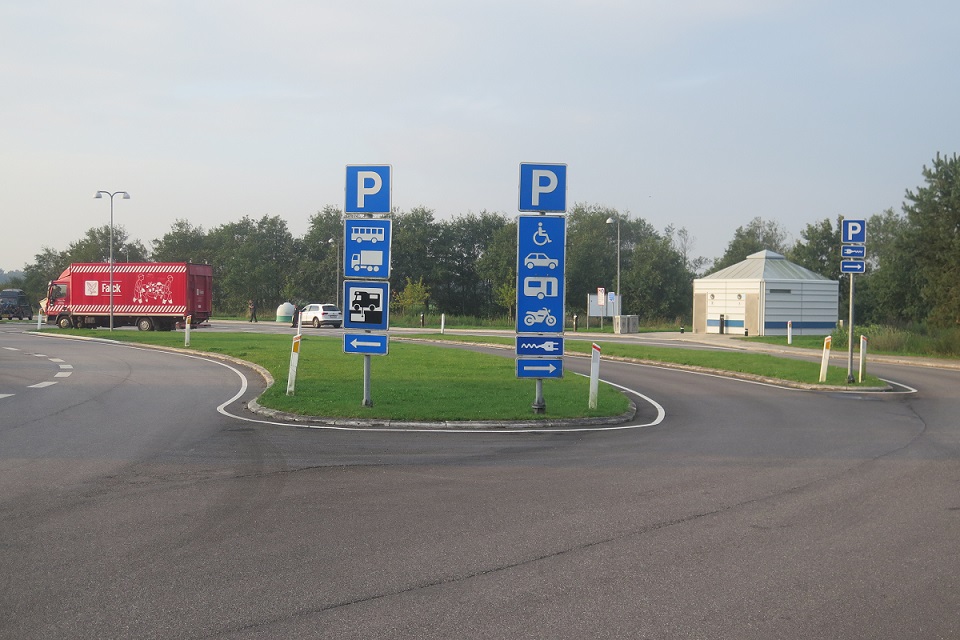On 21 Oct the Herald newspaper published a letter from myself about the need for the Scottish Government to revise the plans for dualling the A9 trunk road, currently under construction, so that new rest and parking areas can be provided. Such areas are the norm in many other European countries. To bring Scotland up to modern European standard the Government needs not only new plans but also a commitment to use compulsory purchase powers to acquired the necessary land from the adjacent landowners. With much of this road project located within the Cairngorms National Park, where new developments should be of the highest quality, Transport Scotland have the responsibility to make substantial improvements on what has gone before.

In a published response to my letter, on 23 Oct, Allan Martin indicated that he was in full support of my concerns over the current plan but also explained that such rest areas were part of the original plans for the current A9 until these were torpedoed by local businesses and politicians. They wanted any traffic that required such facilities to be diverted into nearby communities.

I also recall these pressures. As an Aviemore based local staff member of the Nature Conservancy Council in the late 1970s, I participated in the planning process and public inquiry that accompanied the passage of the new A9 through Badenoch from Drummochter Pass to north of Aviemore. That experience revealed the pressure exerted on transport officials to both divert traffic into local communities for access to facilities but also the pressure exerted by landowners to secure what they wanted from the road construction process. The opening day of the public inquiry featured a whole battery of lawyers representing the top flight of the Scottish and UK legal profession, all representing those who owned land along the route and were objecting to the new road. During the next few days this phalanx of legal expertise slowly melted away. Overnight deals were being done as officials caved in and agreed to every landowner request for a bridge, underpass or direct private access to the new road. No modification of any sort to provide better parking and rest facilities for the general public emerged from this overnight wheeling and dealing. Only one landowner remained, for the rest of the inquiry. He was trying to stop the road going anywhere near his estate. In his persistence he had no legal representative to back him up. He only had his wife beside him to help. At no point did she refer to any report or appear to pass him any advice. She appeared to spend the whole public inquiry quietly knitting. The knitting did not stop the road going through Kinrara estate.
And so the present A9 was built, with no adjacent facilities. Except for Ralia which did get a large car park, set back from the road, with toilets and an information centre. The present cafe came later, once local interests realised that such a facility was needed by the road and it would also provide good job opportunities for local people who could walk or cycle to work from nearby Newtonmore. But the Ralia facility was not built with landowner cooperation. It is only there because at that location was an abandoned quarry and ownership was not an issue as the road builders simply incorporated the land into the road alignment, restoring the remainder of the quarry with landscaping followed by the construction of the Ralia facility and provision of an electricity supply.
But today, away from Ralia, the same landowners, or their successors, with the same high powered legal teams, will confront the Scottish Government over any attempt to modify any of the A9 dualling plans between Perth and Inverness in order to provide parking and rest areas. This challenge will only be overcome if the Transport Secretary, Michael Matheson MSP, makes it clear from day one that compulsory purchase powers will be used, as a matter of course, not as a last resort, to secure the land needed for these essential facilities. Use of such powers can be easily justified – they are needed to meet modern European road network standards, especially when a national park is involved.
To show what is expected, here is a photo, taken last month, of such a parking and rest area in Denmark.
 This facility, set back by 100 metres or so from the main dual carriageway (E45), lies between Hamburg (Germany) and Aalborg (Denmark). It provides for lorry parking separated from car and campervan parking, toilet and wash facilities, campervan waste disposal point, litter bins plus a large roofed skip, picnic benches and short walks looking out over the nearby countryside, electric charging points plus an automatic fuel dispensing facility. At this particular facility no staff were present on site to dispense food or drink or manage the fuel facility. Elsewhere full cafe, shop and supervised fuel facilities may be present, or less, with just parking and toilets provided. At 7 am a vehicle appeared with a maintenance person who emptied all the litter bins into the big skip, checked out the toilets and other waste facilities and with a shovel repaired some of the grass verge damaged by lorry wheels. He left behind an immaculate facility ready for another day of public use and enjoyment. When will Scotland see the same?
This facility, set back by 100 metres or so from the main dual carriageway (E45), lies between Hamburg (Germany) and Aalborg (Denmark). It provides for lorry parking separated from car and campervan parking, toilet and wash facilities, campervan waste disposal point, litter bins plus a large roofed skip, picnic benches and short walks looking out over the nearby countryside, electric charging points plus an automatic fuel dispensing facility. At this particular facility no staff were present on site to dispense food or drink or manage the fuel facility. Elsewhere full cafe, shop and supervised fuel facilities may be present, or less, with just parking and toilets provided. At 7 am a vehicle appeared with a maintenance person who emptied all the litter bins into the big skip, checked out the toilets and other waste facilities and with a shovel repaired some of the grass verge damaged by lorry wheels. He left behind an immaculate facility ready for another day of public use and enjoyment. When will Scotland see the same?
Dave
I entirely agree with the thrust of your Herald letter and Parkwatch article. As a regular late night user of the A9 it never fails to amaze me how full the tight close to road laybys are between Perth and Aviemore with HGVs as drivers try to get some peace to sleep. The current layby provision is grossly inadequate and I agree larger rest areas set well back from the road are required as part of the new A9. Disappointingly the new dual carriageway in the vicinity of Kincraig and currently under construction have a limited number of laybys very close to the new road. A missed opportunity to provide some larger and quieter rest areas set well back from the road.
Some properly designed pull in and rest areas could also double up as car parks for the growing number of walkers
taking to the hills and currently forced to park on road verges.
The parking /rest area example you feature in your article would fit the bill -a dozen or so of these would fit the bill and still protect the opportunity of folks pulling into nearby communities if they want cafe catering facilities.
Plenty of good examples too from North America including near the spectacular Sea to Sky Highway linking Vancouver with the mountain resort of Whistler.
Time for teams and elected members associated with the A( upgrade to be more ambitious and help create a more appealing Highland Highway with scenic lookouts and rest areas which are much more than standard laybys.
Once again Europe has led the world with this, while road authorities in the UK have sat on their hands such rest areas have spread across the world. It is not just a scandal for UK and Scottish tourism either. Today the whole western economy depends for its very lifeblood on the most highly regulated profession that exists anywhere in any field of human activity – international transport operations. Haulage and coach drivers are required to operate within exacting work hours standards imposed by law. How many of our UK transport regulators, road engineers, Planners or Politicians have ever attempted to grab a few hours compulsory rest in the cab of a large vehicle while traffic speeds by within a few feet? How many are compelled by circumstance and regulation to do this night after night? Not many of them ever have – I hazard a guess. One reason transport within the EU economy has functioned so efficiently in recent decades is because German planners foresaw 60 years ago… two full generations ago… the need for public parking at regular intervals. They set aside space for full Rest houses – complete facilities for every type of motorist – very early on. Every other EU nation except GB recognised this provision as an essential public service, and now match this standard. Only Dimwitted UK authorities have regarded such places as a potential for eye-wateringly costly franchise concessions.. It was soon discovered that Franchisees would only commit to invest if these official spaces were kept very few and far between. So the places that do exist were set aside as a money making opportunity only ..never to be seen as an economic essential. The UK trunk road and Motorway service station model first failed totally in the 1970’s . The huge charges for such concessions unaffordable. Today the concept benefits few “Stakeholders”. Narrow minded stupidity surrounding these franchises has deprived everyone on the UK road network of adequate safe spaces to rest up in ever since. Cost free relaxation next to major routes has never been considered an essential for safe travelling across UK. This, for all sorts of reasons, is misguided.
Dear James and Tom
Many thanks for these very helpful comments. I have travelled the sea to sky highway between Vancouver and Whistler and agree that there are many examples from North America that we should also consider, providing our public bodies can re-think their current plans and secure the necessary land for appropriate parking and rest facilities. And thank you for the perspective from the lorry driver – I never understood the basis on which the the motorway service station “ethos” was developed in the UK and I have also wondered how, in Scotland, HGV drivers managed to get any sleep parked in our tiny lay -byes with the rest of the traffic whizzing past their heads a few feet away.
I think there are ministers in the Scottish Government who will be sympathetic to the points being made. I will send this post plus your comments to the Transport Secretary, Michael Matheson MSP and ask what action he proposes to take in response to the current situation and the concerns being expressed.
Scottish road design seems to prioritise minimum land take over everything, as if we were somehow short of it. Even the motorway network has substandard and dangerous places due to this., but they re never identified as contributing to accidents which are all attributed to “driver error”. This was the case in the air transport field years ago until the pilots’ union fought to get it changed, but the private motorist has no such body. The transport unions tried to get it done under health and safety but were told that the vehicle, not the road is the driver’s workplace so the H&S executive would not get involved.
I find it useful to interpret apparently illogical main road speed limit signs as meaning “Danger – substandard and / or dangerous road layout ahead.”
One of the lethal aspects of the current dual sections of the A9 is the sections of separated carriageway which have very few clues to distinguish them from the single carriageway sections with which they alternate frequently. At least some of the head ons which happen every year must be people pulling out to overtake thinking they are on a separated dual section when they aren’t. As far as I know there are no plans to address this.
Given that “transport” is a significantly devolved area of power that sits with the Scottish Government – and has been for some time – there’s no excuse for this. Just because the SNP is a great champion for Independence and the EU doesn’t mean they’re perfect!
The fear of CPO in Transport Scotland is clearly evidenced at the new works on the hill passing Bankfoot on the Luncarty – Pass of Birnam project on the A9. The ‘promintory’ with the wee house on the top and the very steep batter down onto the southbound carriageway looks like a recipe for ongoing issues.
It would be wonderful if we in Scotland could see the advantages to all, travellers and hospitality providers, of modern, clean and welcoming stop-overs. They should be able to bring business to communities, not starve them. I’d be delighted to park my camper on the outskirts of a town or village and walk in to have a meal and a mooch around.
Its beyond high time we caught up!
And those issues at Bankfoot don’t look very far away. Passing there the other day, most of the vegetation cover looks not to have taken, and I have noticed a couple of slips take place, in spite of the mechanical support constructed just below the surface.
At least there is a reasonable stopover nearby, although not really advertised as such.
Nevermind the car parks, why are there no wildlife crossings being built on the new A9? They’re installing them on most of the major roads across continental Europe, so why not here?
Every few miles you have a short tunnel under a wooded embankment which encourages, boar, deer, bear and other creatures to avoid the traffic.
You are not correct, wildlife crossings are being installed on the A9 dualling. On the current section under construction between Luncarty and Pass of Birnham, the new/replacement culverts are equipped with mammal ledges, where previously there were none. The most northerly of the over-bridges at the Gelly Woods is a “green” bridge (half width vegetated and half providing an estate access track) which has been designed to allow free passage of wildlife from the woods.